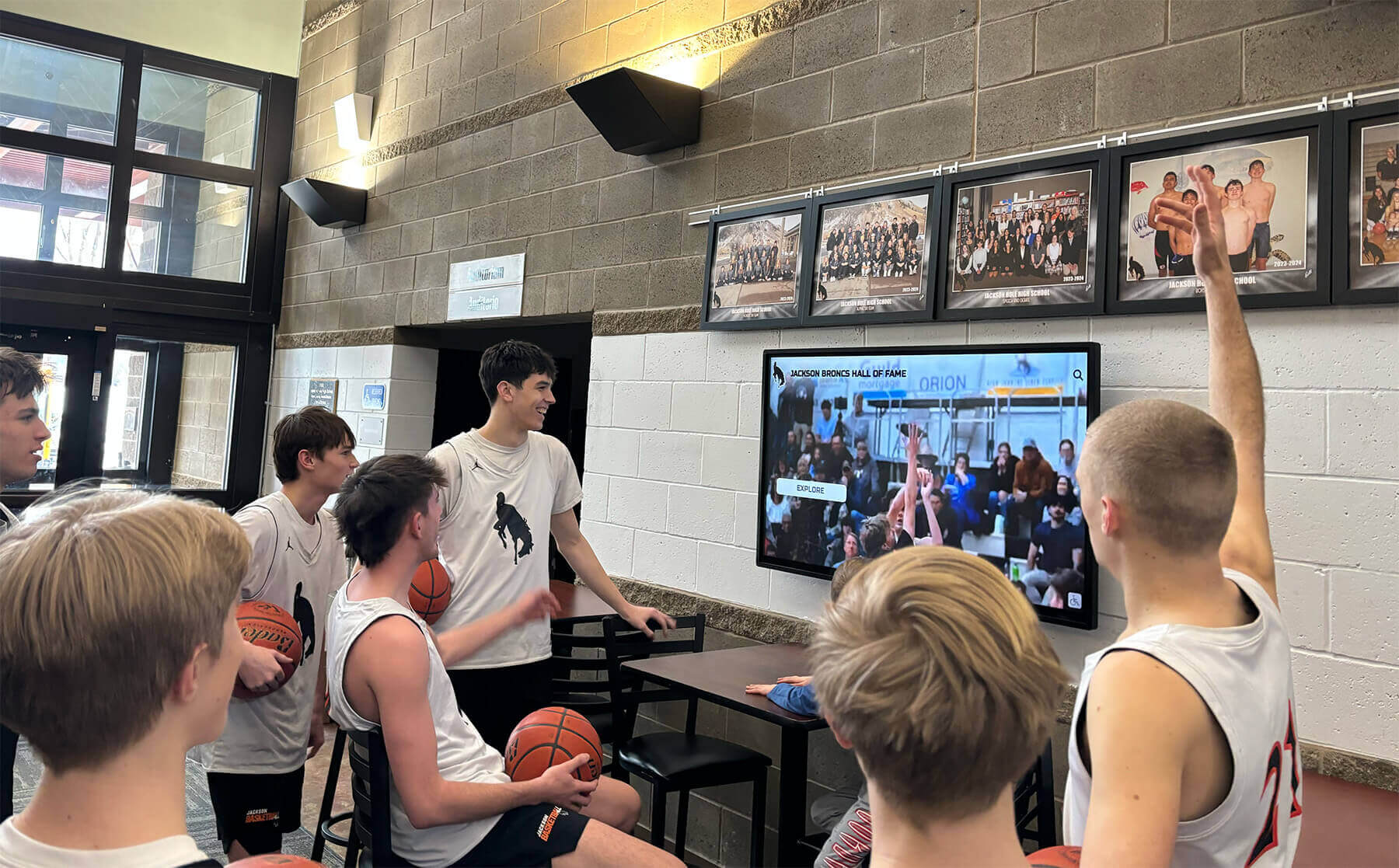Key Takeaways
Discover how fun, interactive school screens transform student engagement through touchscreen technology. Complete 2025 guide to choosing and implementing engaging digital displays for schools.
Walk through any modern school hallway and you’ll likely encounter students gathered around a glowing screen, tapping, swiping, and exploring content with genuine interest. These “fun school screens”—interactive touchscreen displays designed specifically for educational environments—represent far more than digital bulletin boards. They’re engagement engines that transform passive spaces into interactive learning environments while celebrating achievement, sharing information, and building school culture in ways traditional displays never could.
Schools implementing these interactive solutions consistently report increased student engagement, stronger school spirit, improved information sharing, and measurable returns on technology investments. But with dozens of options ranging from basic digital signage to sophisticated interactive recognition platforms, how do schools choose solutions that deliver genuine value rather than becoming expensive installations that lose relevance after initial novelty fades?
This comprehensive guide examines everything schools need to know about implementing fun, interactive touchscreen displays that maintain student interest and deliver lasting educational and cultural value throughout 2025 and beyond.
What Makes a School Screen “Fun” and Engaging?
The difference between digital displays students ignore and interactive screens that consistently attract attention comes down to several critical factors distinguishing genuine engagement platforms from basic digital signage.
Interactive vs. Passive Display Technology
Traditional digital signage displays static or rotating content that students passively view while passing. While these systems serve basic information-sharing purposes, they rarely create the engagement and interaction that defines truly “fun” school screens.
Interactive touchscreen displays fundamentally change this dynamic by inviting active participation. Students don’t just glance at content—they explore, search, discover, and interact with information that interests them personally. This active engagement creates memorable experiences while delivering information more effectively than passive viewing ever could.
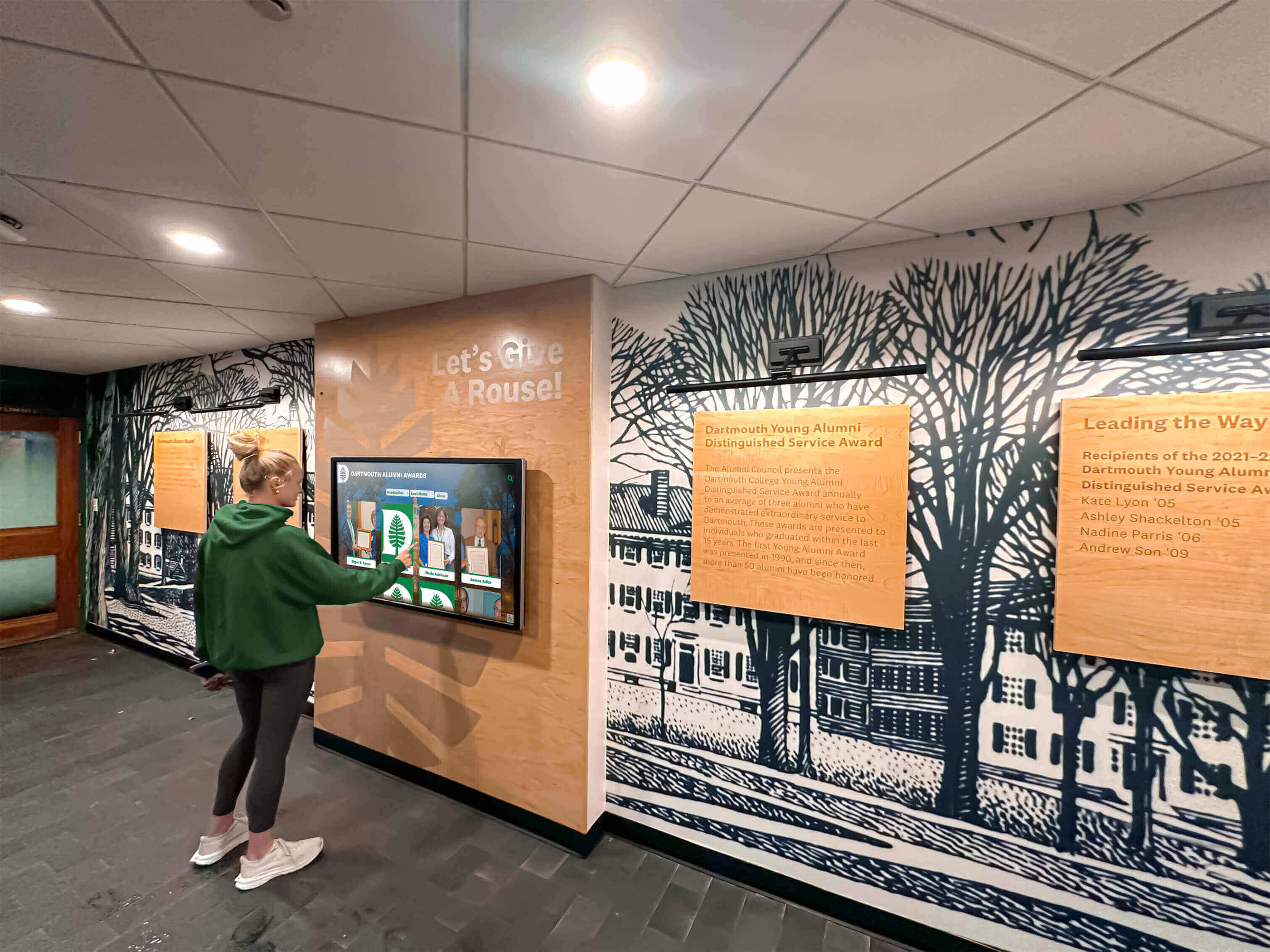
Gamification and Interactive Elements
The most engaging school screens incorporate game-like elements that make interaction enjoyable rather than merely functional. Touch-responsive interfaces with smooth animations, search functionality allowing students to find personal connections, multimedia content including photos, videos, and audio, achievement showcases where students can find themselves and classmates, and interactive timelines and historical explorations all contribute to creating experiences students genuinely want to engage with rather than feeling obligated to use.
According to education technology research, schools implementing gamified interactive displays report significant increases in student participation and information retention compared to traditional static displays. The key lies in making interaction intrinsically rewarding rather than simply digitizing traditional bulletin board content.
Personalization and Discovery Features
Students engage most deeply with content they can personalize and explore based on their interests. The most effective fun school screens enable searching by name to find personal achievements and connections, filtering by category, year, sport, or activity, browsing related content and suggested profiles, discovering connections between current students and alumni, and exploring school history through interactive timelines.
This personalization transforms screens from general-purpose displays into personal discovery tools where every student can find relevant, meaningful content creating individual connections to broader school communities.
Types of Fun Interactive Screens for Schools
Different interactive screen applications serve distinct purposes within educational environments. Understanding these categories helps schools select appropriate solutions for specific needs and locations.
Recognition and Achievement Displays
Perhaps the most popular and engaging interactive screen application celebrates student and alumni achievements through searchable, interactive platforms showcasing accomplishments across athletics, academics, arts, and service.
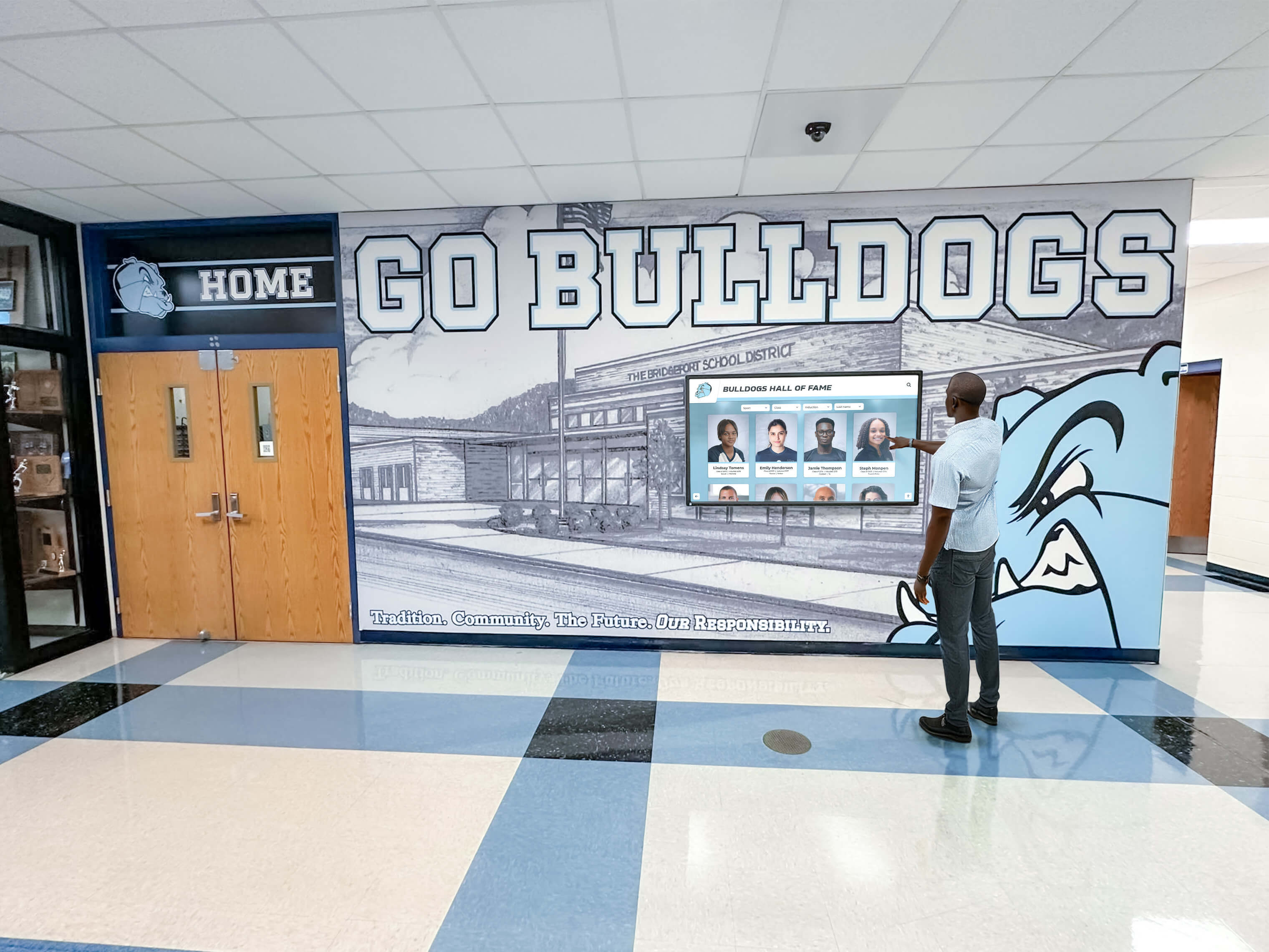
Unlike traditional trophy cases with limited physical space, digital recognition displays provide unlimited capacity for honoring achievements. A single screen can showcase thousands of accomplishments, profiles, and historical records that would require dozens of physical display cases occupying hundreds of linear feet.
Students love finding themselves, their friends, and family members who attended their schools. This personal connection drives repeated engagement as students return to screens multiple times throughout school years to explore new content and share discoveries with friends and family.
Solutions like Rocket Alumni Solutions specialize in these recognition applications, providing purpose-built platforms designed specifically for celebrating achievement through interactive, searchable displays accessible both on campus and online through companion mobile applications.
For schools looking to implement comprehensive recognition programs, digital trophy cases offer modern alternatives to traditional physical displays while providing significantly enhanced engagement capabilities.
Interactive Information and Wayfinding Kiosks
Large school campuses benefit from interactive screens helping visitors, students, and staff navigate facilities and find information quickly. These wayfinding kiosks typically feature building directories and maps, event calendars and schedules, room locators and availability, staff directories with photos and contact information, and visitor check-in functionality.
The interactive nature makes these systems far more effective than static building directories. Users can search for specific locations, zoom into detailed area maps, and receive step-by-step directions to destinations—capabilities impossible with traditional signage.
Student Work Showcases and Digital Galleries
Creative programs including art, music, drama, and multimedia courses benefit tremendously from interactive screens showcasing student work in engaging digital formats. These screens can display rotating digital art galleries with artist statements, video performances and concerts, student film and animation projects, creative writing and journalism, and design portfolios and project documentation.
According to educators implementing these systems, digital showcases dramatically increase the audience for student work compared to physical displays limited to specific locations and viewing times. Students whose work appears on interactive screens report feeling more valued and motivated, while the school community gains greater appreciation for creative program quality.
Schools seeking to implement comprehensive arts recognition might explore digital arts and music showcase solutions specifically designed for highlighting creative achievements.
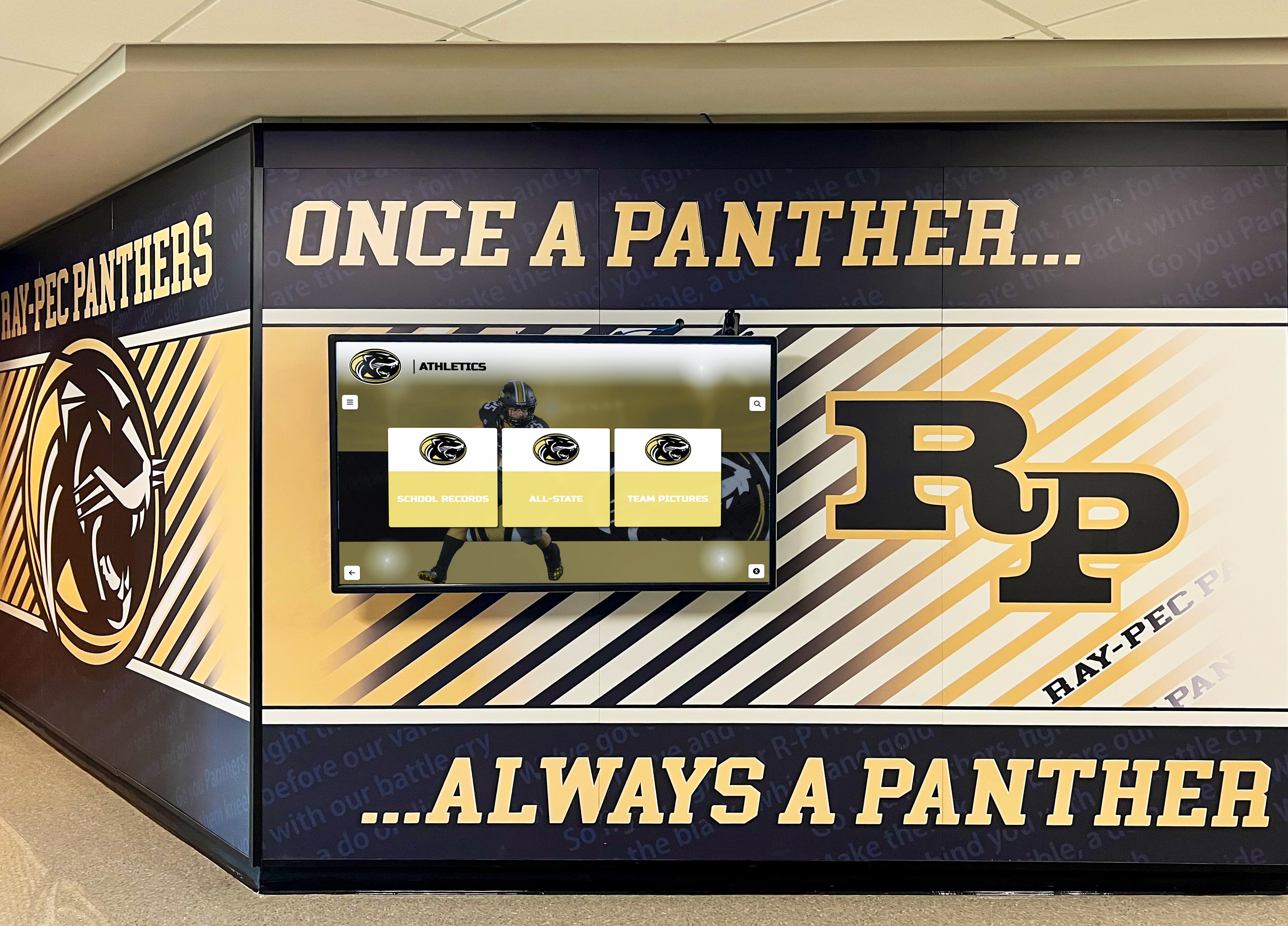
Academic Recognition and Honor Roll Displays
Beyond athletic and arts recognition, interactive screens celebrating academic excellence create powerful motivation while honoring intellectual achievement. These displays can feature honor roll students by marking period, National Merit Scholars and AP Scholars, academic competition winners, scholarship recipients, GPA milestones and academic letter recipients, and subject-specific achievement recognition.
Digital academic recognition solves a persistent challenge traditional honor roll displays face: limited space forcing schools to remove previous recognition when new achievements occur. Interactive platforms maintain permanent records of all academic honors, allowing students and families to find recognition from any year rather than only the most recent marking period.
For comprehensive guidance on implementing these programs, schools can reference best practices for interactive boards celebrating student achievements across all academic categories.
Community Engagement and Alumni Connection Platforms
Interactive screens create valuable touchpoints connecting current students with alumni networks and community resources. These platforms can showcase distinguished alumni profiles and career paths, community partner and sponsor recognition, college and career pathway information, mentorship program connections, and alumni event announcements and registration.
These connections prove particularly valuable for high school students exploring career options and college paths. Seeing profiles of alumni who attended their schools and achieved success in various fields provides tangible examples of possibilities while creating aspirational role models.
Key Features That Make School Screens Engaging and Fun
Certain capabilities distinguish truly engaging interactive screens from basic touchscreen displays. Schools should prioritize these features when evaluating options.
Intuitive Touch Interface Design
The interface makes or breaks user engagement. Screens requiring complicated navigation or unclear touch targets frustrate users and discourage interaction. Effective designs feature large, clearly labeled touch targets suitable for all ages, intuitive navigation requiring no instructions, responsive touch feedback confirming interactions, consistent design patterns throughout the interface, and accessibility features supporting users with varying abilities.
Testing interfaces with actual students during evaluation phases reveals usability issues before implementation. If middle school students can navigate systems effectively without instruction, designs will likely succeed. If they struggle, even sophisticated features won’t drive engagement.
Multimedia Content Integration
Static photos alone rarely maximize engagement potential. The most compelling fun school screens integrate rich multimedia including high-resolution photos and image galleries, embedded video highlights and performances, audio clips and recorded messages, document viewers for newspapers and publications, and social media feed integration when appropriate.
This multimedia approach tells more complete stories than photos alone. Championship game video highlights create more powerful experiences than static team photos. Performance recordings showcase talent more effectively than cast photos. Scholarship acceptance videos capture emotion that text descriptions cannot convey.
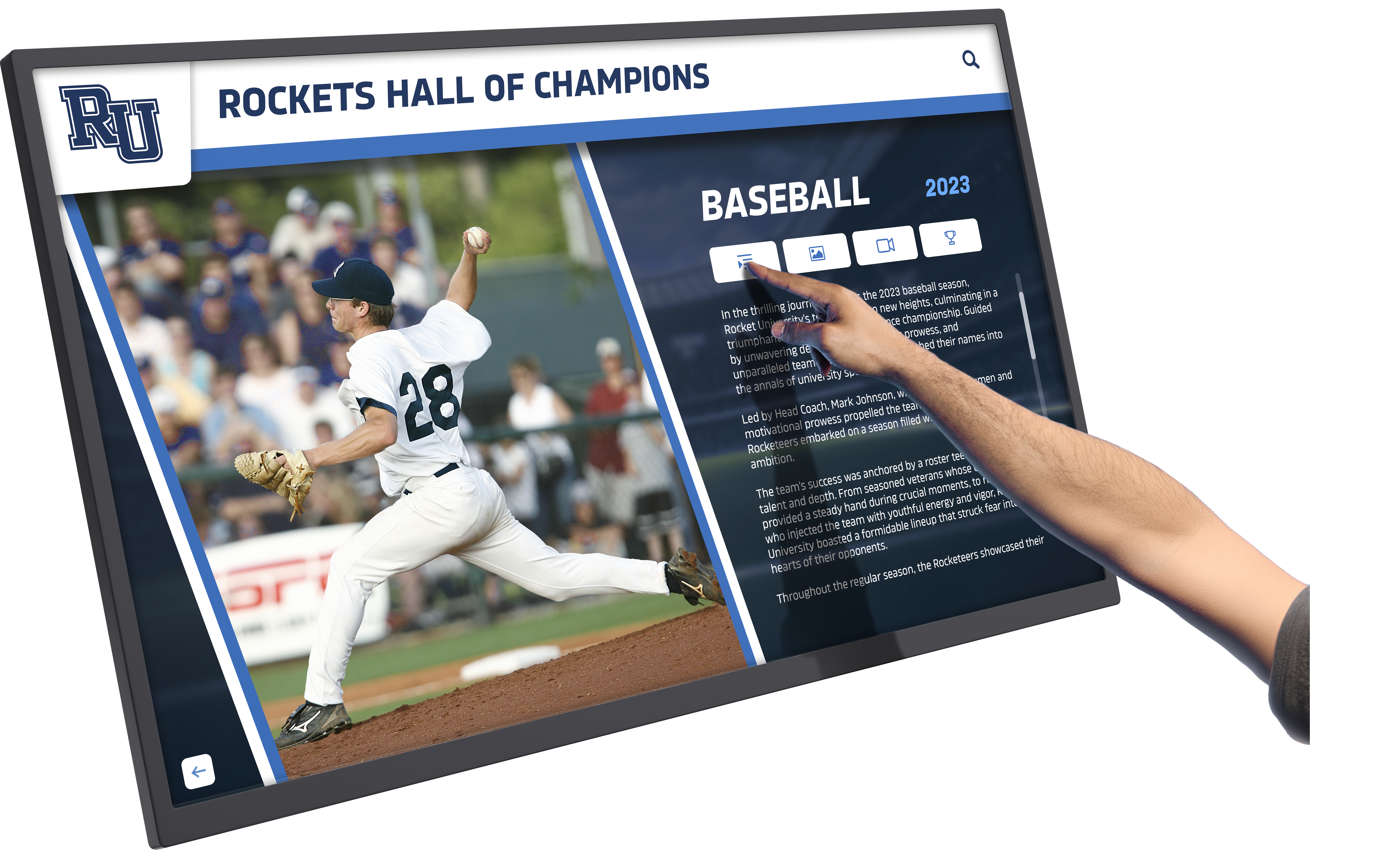
Powerful Search and Discovery Tools
Students engage most when they can quickly find content relevant to their interests. Robust search functionality should include name search finding specific individuals, filter options by year, category, achievement type, keyword search across all content, related content suggestions, and random discovery features highlighting diverse content.
Search speed proves critical—results should appear nearly instantaneously. Delays of even a few seconds diminish engagement as students lose patience with sluggish systems. Cloud-based platforms generally deliver faster search performance than locally hosted solutions, particularly when dealing with large content databases.
Real-Time Content Updates
Engagement depends partly on freshness. If students see the same content month after month, screens become wallpaper they subconsciously ignore. Regular updates maintain interest by giving students reasons to repeatedly check displays for new content.
The most effective systems enable easy, real-time content updates through cloud-based content management accessible from any device, scheduling features publishing content at predetermined times, bulk upload capabilities for adding multiple entries efficiently, mobile app management allowing updates from phones and tablets, and version control preventing accidental content deletion.
Schools implementing systems with these management features report significantly higher content freshness and sustained student engagement compared to platforms requiring complicated technical processes for updates.
Social Sharing and Mobile Integration
Extending engagement beyond physical displays multiplies impact. Features connecting physical screens to mobile experiences include QR code scanning linking to detailed online profiles, social media sharing buttons for appropriate content, companion mobile apps mirroring on-screen content, remote viewing allowing alumni access from anywhere, and text-to-phone features sending information directly to devices.
According to engagement analytics, schools offering mobile companion apps see 3-4 times more content interactions than those with only physical displays. Students share discoveries with family members, alumni browse content remotely, and engagement extends far beyond brief physical encounters with screens.
Implementing Fun School Screens: Best Practices for Success
Technology quality matters, but implementation approach ultimately determines success or failure. Schools reporting highest satisfaction with interactive displays follow consistent best practices.
Strategic Placement for Maximum Engagement
Location dramatically affects engagement levels. The most effective placements position screens in high-traffic areas where students naturally gather, at comfortable viewing and interaction heights (generally 42-48 inches from floor to screen center), with adequate space for small groups to gather without blocking traffic, away from direct sunlight creating glare, and near seating areas encouraging extended exploration.
Main lobbies and entrances, cafeterias and common areas, athletic facility entrances, performing arts centers, and library/media center spaces all represent high-value locations. Conversely, tucking screens into little-used corners or narrow hallways wastes investment regardless of technology quality.
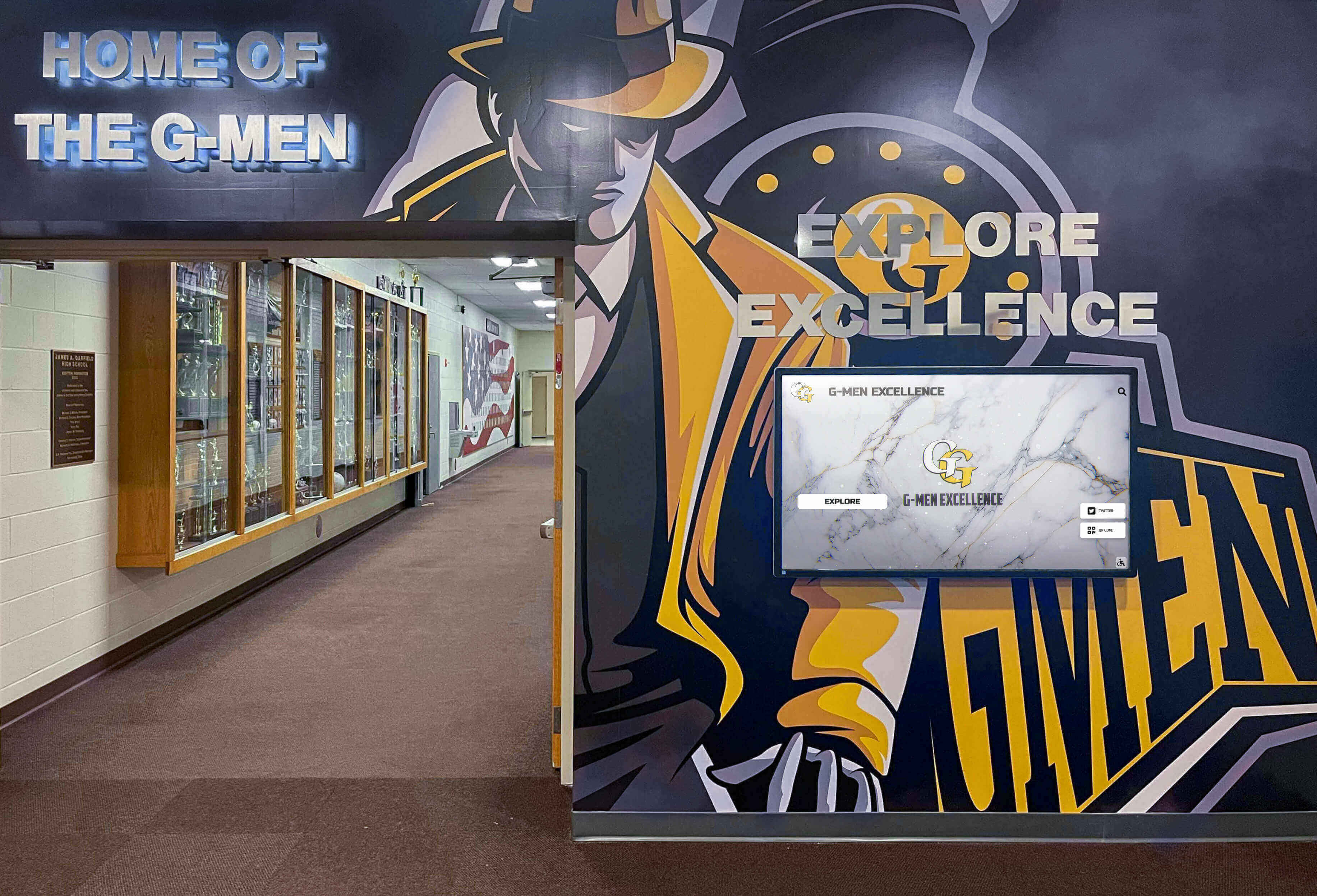
Content Strategy and Launch Planning
Successful launches require substantial initial content providing immediate value rather than promising future additions. Best practices include gathering 100+ initial entries before launch across multiple categories, including recent achievements ensuring current students find themselves, adding historical content connecting to institutional traditions, incorporating multimedia elements demonstrating full capabilities, and testing all functionality with student focus groups before public launch.
Schools sometimes launch displays with minimal content planning to “add more later.” This approach inevitably disappoints as students encounter sparse content creating poor first impressions difficult to overcome. Investing adequate time in pre-launch content development pays dividends through strong initial engagement establishing positive patterns.
Ongoing Content Management and Maintenance
Initial launch enthusiasm means nothing without sustained content management. Successful programs designate clear ownership for content responsibilities, establish regular update schedules ensuring consistent freshness, develop processes for capturing new achievements promptly, maintain content quality standards for all submissions, and analyze engagement data informing content strategy.
Many schools find success distributing content responsibilities across multiple stakeholders—athletic directors managing sports content, academic coordinators handling honor roll updates, activities directors adding club and organization recognition. This distributed model spreads workload while ensuring subject matter expertise guides content creation.
Student Involvement and Ownership
The most engaging fun school screens involve students in content creation and curation. Student involvement might include journalism students conducting alumni interviews, video production classes creating highlight reels, digital media students designing graphics and layouts, student government coordinating recognition nominations, and service learning students managing historical research projects.
This involvement builds student investment in success while developing real-world skills in content creation, interviewing, multimedia production, and digital publishing. Students take pride in contributing to visible school assets while learning valuable competencies.
Measuring Success and Adjusting Strategy
Data-driven approaches maximize effectiveness over time. Schools should track engagement metrics including interaction frequency and duration, search queries revealing content interests, most-viewed profiles and categories, time-of-day usage patterns, and user feedback through surveys and observations.
Most professional interactive display platforms include built-in analytics dashboards providing these insights without additional effort. Reviewing data quarterly allows adjusting content strategy, identifying gaps, and optimizing for demonstrated student interests rather than assumed preferences.
Choosing the Right Interactive Screen Solution for Your School
Dozens of vendors offer interactive display products, but capabilities and suitability for educational environments vary dramatically. Schools should evaluate options carefully across multiple criteria.
Hardware Considerations and Display Selection
Physical display quality and durability matter tremendously in school environments with intensive daily use. Key hardware considerations include commercial-grade displays rated for 16+ hour daily operation, tempered glass surfaces withstanding thousands of touches, display sizes appropriate for viewing distances (generally 55-75 inches for most school applications), adequate brightness (450+ nits) for spaces with significant ambient light, and mounting solutions ensuring security while providing proper ventilation.
Consumer-grade televisions and tablets lack durability for institutional environments and inevitably fail prematurely despite lower initial costs. Commercial displays carry higher upfront prices but deliver 10+ year lifespans justifying investment through reliability and longevity.
Software Platform Capabilities
Software determines daily user experience and long-term value. Critical software features include intuitive content management requiring no technical expertise, robust search and filtering functionality, multimedia support for photos, videos, and documents, mobile companion applications extending access, cloud-based architecture enabling remote management, regular updates and feature additions, and comprehensive analytics tracking engagement.
Generic digital signage platforms designed for retail advertising typically lack the interactive depth, searchability, and recognition-specific features educational environments require. Purpose-built education solutions deliver capabilities aligned with school needs.
For schools exploring comprehensive options, resources comparing touchscreen banner displays designed specifically for educational recognition provide valuable evaluation frameworks.
Total Cost of Ownership and Budget Planning
Interactive displays represent significant investments requiring comprehensive budget planning beyond initial hardware costs. Complete cost analysis should include display hardware and mounting equipment, software licensing and subscription fees (typically $2,000-5,000 annually for education platforms), installation and infrastructure work, initial content development, training and professional development, ongoing support and maintenance, and eventual hardware refresh (plan for 7-10 year cycles).
Complete installations typically range from $8,000-15,000 for single displays including hardware, software, installation, and initial content development. Multi-display implementations and larger format screens run higher, while basic solutions with limited functionality may cost less but deliver proportionally reduced value.
Many schools successfully fund installations through PTA/booster club contributions, alumni giving campaigns, corporate sponsorships, facility improvement bond issues, technology budget allocations, and memorial gifts and named recognition opportunities.
Vendor Support and Service Quality
Responsive vendor support makes the difference between thriving implementations and frustrating experiences. Evaluate vendors based on training provided during implementation, technical support responsiveness and availability, content migration assistance for historical records, regular software updates and feature additions, professional development resources for ongoing learning, and reference installations at similar schools.
Request conversations with current customers at comparable schools. Ask specifically about responsiveness when issues arise, ease of content management, and whether they would choose the same solution knowing what they know now. Candid customer feedback reveals vendor strengths and weaknesses no marketing materials disclose.
Making School Screens Work Across Different Settings
While core principles remain consistent, optimal approaches vary based on school level and specific contexts.
Elementary School Implementations
Elementary implementations prioritize age-appropriate content and interaction. Effective approaches include celebrating “student of the month” and positive behavior, showcasing classroom projects and artwork, building reading and academic achievement recognition, highlighting community helpers and classroom volunteers, and creating simple, colorful interfaces appropriate for young users.
Interactive screens in elementary settings often see significant parent engagement as families explore content during pickup/dropoff, school events, and parent-teacher conferences. This family engagement extends impact beyond student interaction alone.
For comprehensive guidance on elementary recognition programs, student of the month recognition program resources provide implementation frameworks appropriate for younger grades.
Middle School Applications
Middle school students seek content connecting them to broader school communities while establishing individual identities. Successful approaches include athletic and academic team recognition, club and activity participation, arts and performance showcases, community service hours and impact, and connections between current students and alumni role models.
Middle schoolers particularly enjoy search functionality allowing them to find older siblings, parents, and other family members who attended their schools. These connections help students visualize their places within continuing traditions.
High School Environments
High school implementations can leverage more sophisticated features and content. Effective approaches include comprehensive athletic halls of fame spanning decades, distinguished alumni career profiles and pathways, college signing celebrations and scholarship recognition, performing arts portfolios and competitions, and community impact and service learning projects.
High school students expect professional quality and appreciate sophisticated search, filtering, and discovery features. They’ll engage deeply with comprehensive content but quickly dismiss sparse implementations that feel unfinished or poorly maintained.
College and University Settings
Higher education implementations often focus on alumni engagement while supporting development and advancement goals. Typical applications include athletic halls of fame and record books, distinguished alumni recognition across fields, major gift donor recognition and stewardship, departmental history and evolution, and research accomplishments and faculty achievement.
University implementations frequently integrate with alumni databases and advancement systems, enabling sophisticated donor recognition workflows and automated profile updates. These integrations maximize value while minimizing manual data entry.
Current Trends and Future Directions
Interactive display technology continues evolving rapidly, with several emerging trends promising enhanced engagement and expanded capabilities.
Artificial Intelligence and Personalization
AI-powered features will enable increasingly personalized experiences including intelligent search understanding natural language queries, automated content recommendations based on user interests, voice interaction for hands-free accessibility, facial recognition suggesting relevant content (in privacy-compliant implementations), and predictive analytics optimizing content strategy.
These capabilities will make displays progressively more intuitive and valuable as systems learn user preferences and adapt presentations accordingly.
Enhanced Multimedia and Immersive Experiences
Advancing technology enables richer content presentations including high-dynamic-range displays with exceptional image quality, spatial audio creating immersive soundscapes, augmented reality overlays connecting physical and digital content, 3D visualizations and interactive models, and holographic displays creating compelling visual effects.
While some capabilities remain experimental, mainstream educational applications will incorporate many of these features within coming years as costs decline and reliability improves.
Integration with School Ecosystems
Interactive displays will increasingly integrate with other school systems including student information systems for automatic honor roll updates, athletic and activities management platforms, learning management systems highlighting academic achievements, alumni databases maintaining current information, and social media platforms for appropriate content sharing.
These integrations reduce manual data entry while ensuring content remains current and comprehensive without requiring extensive administrative overhead.
Accessibility and Universal Design
Future implementations will prioritize accessibility for users with varying abilities through screen readers and audio descriptions, adjustable text sizes and high-contrast modes, multilingual interfaces serving diverse communities, height-adjustable mounts accommodating wheelchair users, and voice control for users with limited mobility.
Universal design principles ensure everyone can engage with content regardless of abilities, strengthening inclusive school cultures while meeting accessibility requirements.
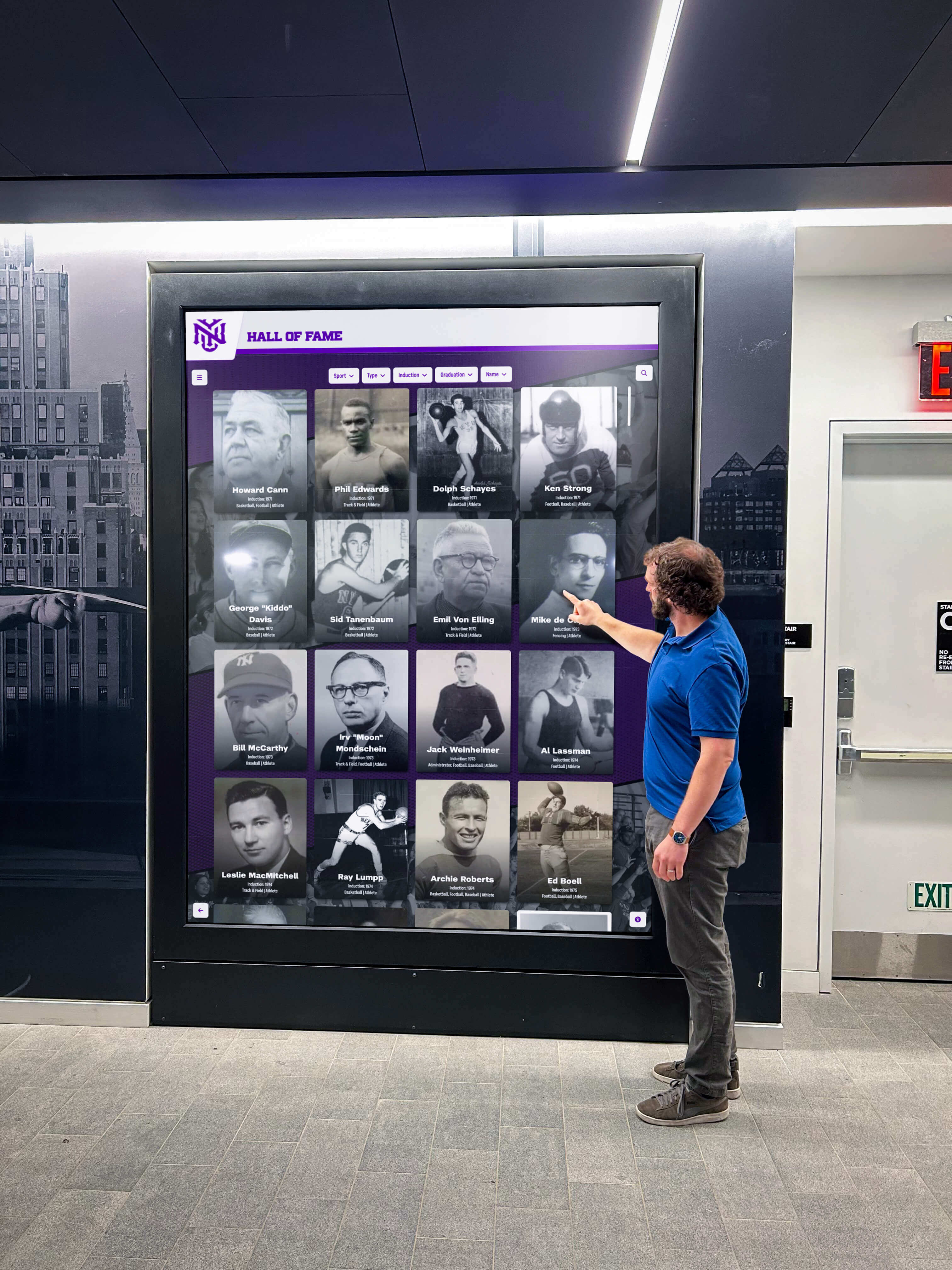
Common Challenges and Solutions
Schools implementing interactive displays occasionally encounter challenges. Understanding common issues and proven solutions helps avoid pitfalls.
Managing Content Volume and Organization
As content libraries grow, organization becomes increasingly critical. Solutions include implementing clear taxonomy and categorization systems, using tags and keywords enabling multiple access paths, creating curated collections highlighting themed content, archiving outdated content while maintaining accessibility, and developing editorial calendars ensuring regular updates.
Maintaining Student Interest Over Time
Initial novelty inevitably fades. Sustained engagement requires regularly adding new content maintaining freshness, promoting new features and content through announcements, creating seasonal themes and rotating highlights, encouraging student participation in content creation, and analyzing engagement data to optimize strategy.
Technical Issues and Troubleshooting
Even reliable systems occasionally experience technical problems. Effective support structures include designating on-site technology coordinators, maintaining vendor support contact information, creating backup content caches for offline functionality, documenting common issues and solutions, and scheduling preventive maintenance preventing problems.
Balancing Recognition Across Programs
Schools must carefully balance recognition ensuring all programs receive appropriate visibility. Strategies include establishing clear recognition criteria across categories, tracking recognition distribution by program type, actively soliciting content from underrepresented programs, creating dedicated highlight rotations ensuring diversity, and communicating recognition philosophies transparently.
Conclusion: Transforming School Culture Through Engaging Interactive Displays
Fun school screens represent far more than technology installations—they’re cultural catalysts transforming how schools celebrate achievement, share information, and build community. When implemented thoughtfully with appropriate technology, compelling content, and sustained commitment, interactive displays create engagement that strengthens school culture while honoring accomplishment across generations.
The key lies in choosing solutions designed specifically for educational recognition rather than adapting generic digital signage platforms never intended for interactive engagement. Purpose-built platforms like Rocket Alumni Solutions deliver features schools need including intuitive content management, robust search and discovery, multimedia storytelling, mobile integration, and comprehensive analytics—all designed around educational environments and recognition priorities.
Schools successfully implementing interactive displays report measurable benefits including increased student engagement with school history and traditions, stronger connections between current students and alumni, improved recognition program comprehensiveness and inclusivity, enhanced visitor experiences during campus tours and events, and demonstrable returns on technology investments through sustained utilization.
Ready to explore how fun, engaging interactive screens can transform your school’s recognition programs and student engagement? Contact Rocket Alumni Solutions to discover comprehensive platforms designed specifically for educational recognition. From interactive hall of fame displays celebrating athletic achievement to academic honor roll touchscreens highlighting scholarly excellence, modern interactive technology creates educational experiences that inspire while honoring accomplishment across your entire school community.
The future of school recognition is interactive, engaging, and accessible to all. The question isn’t whether to implement these solutions—it’s when your school will join the thousands already benefiting from technology that makes celebrating achievement genuinely fun for students, staff, and communities alike.
